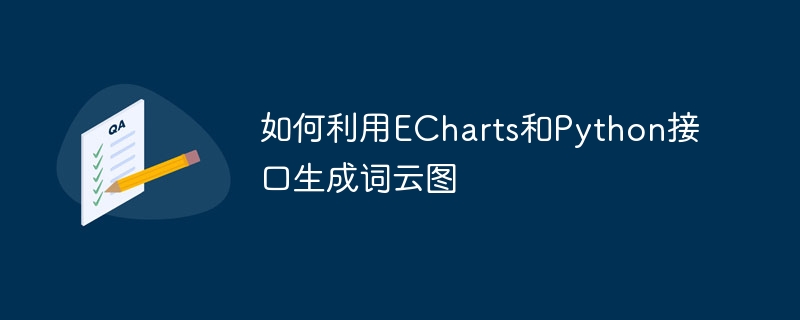

How to use ECharts and Python interface to generate word cloud graph
Introduction:
With the advent of the big data era, data visualization has become indispensable in data analysis of a link. As a common data visualization method, word cloud graph has unique advantages in displaying the distribution and correlation of hot words in text data. This article will introduce how to use ECharts and Python interfaces to generate word cloud diagrams, and provide specific code examples.
1. Preparation:
Before starting, we need to install ECharts and Python related libraries. First, we need to install ECharts through the following command:
npm install echarts
Then, we need to install the pyecharts library in Python, which can be completed through the following command:
pip install pyecharts
After the installation is complete, we You also need to install the jieba library for Chinese word segmentation. You can install it through the following command:
pip install jieba
2. Data processing:
Before generating the word cloud graph, we need to process and prepare the text data to be analyzed. deal with. First, read the text data into Python. You can use the read_csv() function in the pandas library to read the text data. Next, we need to perform Chinese word segmentation on the text data. Here we use the jieba library to handle the word segmentation task. The specific code is as follows:
import pandas as pd
import jieba
# 读取文本数据
data = pd.read_csv('data.csv', encoding='utf-8')
# 对文本进行分词
def cut_words(text):
return " ".join(jieba.cut(text))
# 应用分词函数
data['segment'] = data['text'].apply(cut_words)
# 保存分词后的数据
data.to_csv('segment_data.csv', encoding='utf-8', index=False)In the above code, the text data is stored as a data.csv file, and the processed data is stored as a segment_data.csv file.
3. Generate word cloud diagram:
After we have completed the preprocessing of the data, we can start to generate the word cloud diagram. Here, we will use the WordCloud component from the pyecharts library to generate a word cloud graph. The specific code is as follows:
from pyecharts.charts import WordCloud
from pyecharts import options as opts
# 读取分词后的数据
segment_data = pd.read_csv('segment_data.csv', encoding='utf-8')['segment'].tolist()
# 统计词频
word_count = {}
for text in segment_data:
words = text.split()
for word in words:
if word in word_count:
word_count[word] += 1
else:
word_count[word] = 1
# 生成词云图
wordcloud = (
WordCloud()
.add("", list(word_count.items()), word_size_range=[20, 100])
.set_global_opts(title_opts=opts.TitleOpts(title="词云图"))
)
# 保存词云图
wordcloud.render('wordcloud.html')In the above code, we first read the data after word segmentation, and then count the word frequency of each word. Next, use the WordCloud component to generate a word cloud chart and set the title to "Word Cloud Chart". Finally, save the generated word cloud graph as a wordcloud.html file.
4. Display the word cloud chart:
After generating the word cloud chart, we can display the results on the web page, which can be achieved using the Flask framework. The specific code is as follows:
from flask import Flask, render_template
app = Flask(__name__)
@app.route("/")
def index():
return render_template('wordcloud.html')
if __name__ == "__main__":
app.run()In the above code, we created a simple application based on the Flask framework. When the root directory is accessed in the browser, the generated word cloud diagram will be displayed.
Conclusion:
This article introduces the specific steps of how to use ECharts and Python interfaces to generate word cloud diagrams, and provides corresponding code examples. By mastering these basic knowledge, we can make better use of data visualization tools to display the characteristics and correlations of text data and provide a more intuitive reference for data analysis. Hope this article helps you!
The above is the detailed content of How to generate word cloud graph using ECharts and Python interface. For more information, please follow other related articles on the PHP Chinese website!




